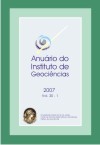Life habits of Gastropoda and Bellerophontida of the Maecuru formation, Middle Devonian, Amazonas Basin, Brazil
DOI:
https://doi.org/10.11137/2007_1_197-203Abstract
The Maecuru Formation comprises the Devonian-Carboniferous sedimentary sequence of Amazonas Basin and consists of fluvialdeltaics to neritics sandstones and pelites layers. Its fossiliferous sediments (the uppermost part of the Lontra Member) consists of hummocky cross-stratified fine-grained to very coarse sandstones beds.With the purpose of adding more information about the palaeoecology of The Maecuru Formation fossils, the life habits of gastropods and bellerophontids were inferred based on functional analysis and similarities with the living forms. The more significant features used were: (1) total frontal cross-sectional area, (2) height and relative positions of pressure point and center of gravity, (3) apertural margin morphology, (4) kind of symmetry and (5) surface smoothness. The species Platyceras (Orthonychia) steinmanni; Platyceras (Tumbophalus) hartti; Platyceras (Platyostoma) darwini; Platyceras (Platyostoma) (?) agassizi; Platyceras (Orthonychia) meerwarthi; Platyceras (Orthonychia) gracilis; Platyceras (Tumbophalus) coutoanus; "Platyceras" tschernischewi; "Platyceras" subconicum; "Platyceras" (Ortonychia) hussaki; "Platyceras" (Ortonychia) whitii; "Platyceras" (Ortonychia) whitii var. curua and "Platyceras" symmetricum var. maecuruensis represent the epifaunal gastropods with low mobility (coprophagous/suspension feeders) of the Maecuru Formation, living symbiotically directly over the anus of a crinoid or nearby. This coprophagous mode of life was probably a non-obligate relationship, because only the closest organisms will get all the advantages of using the crinoid host as a nutrient source. The others adult platyceratids would have a broader feeding repertoire, like as suspension feeders. The bellerophonts Plectonotus (Plectonotus) derbyi, Plectonotus (?) (Plectonotus) salteri e Bucanella reissi would have an epifaunal medium to high mobility, showing a predator habit preferably. On the other hand Bucania freitasi, Ptomatis forbesi and Bellerophon steltzneri showed morphologies compable to a grazer habit with medium mobility. This relative high diversity of gastropods and bellerophonts corroborates the environment of medium and inner shelf inferred for the Maecuru Formation among the others macrofossils, since the majority of Paleozoic fauna of gastropods were typically from shallow seas.Downloads
Download data is not yet available.
Downloads
Published
2007-01-01
How to Cite
Ponciano, L. C. M. de O. (2007) “Life habits of Gastropoda and Bellerophontida of the Maecuru formation, Middle Devonian, Amazonas Basin, Brazil”, Anuário do Instituto de Geociências. Rio de Janeiro, BR, 30(1), pp. 197–203. doi: 10.11137/2007_1_197-203.
Issue
Section
Article
License
This journal is licensed under a Creative Commons — Attribution 4.0 International — CC BY 4.0, which permits use, distribution and reproduction in any medium, provided the original work is properly cited.















